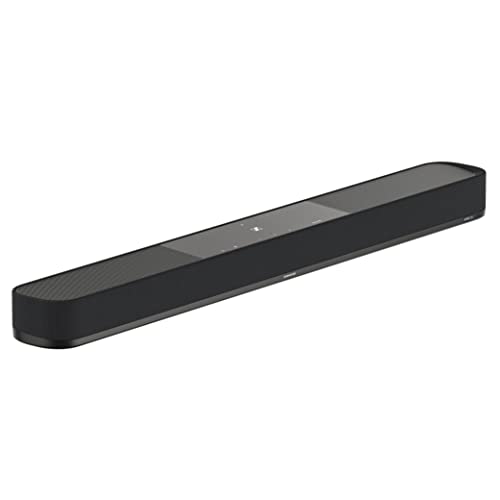
When it comes to upgrading your home theater audio in 2024, two standout options are the Sennheiser AMBEO Soundbar Plus ($1,499.95) and the JBL Bar 1000 ($1,139.95). Both promise theater-quality sound, but they take remarkably different approaches to delivering it. Let's dive into how these systems work and which might be right for your setup.
Today's home theater audio has come a long way from basic stereo. Modern systems create immersive "3D audio" that can make sounds appear to come from any direction - even above you. This is achieved through a technology called Dolby Atmos, which treats sounds as individual "objects" that can be precisely placed in space.
The challenge is delivering this experience without filling your room with speakers. This is where our two contenders take different paths.
The AMBEO Soundbar Plus, released in September 2022, uses advanced beam-forming technology - think of it as precisely aimed "beams" of sound that bounce off your walls to create virtual speakers. It's all done from a single sleek bar.
The JBL Bar 1000 takes a more traditional route with actual physical speakers - including a separate subwoofer for bass and detachable rear speakers that you can place behind your seating area. It hit the market around the same time but offers a different vision of premium audio.
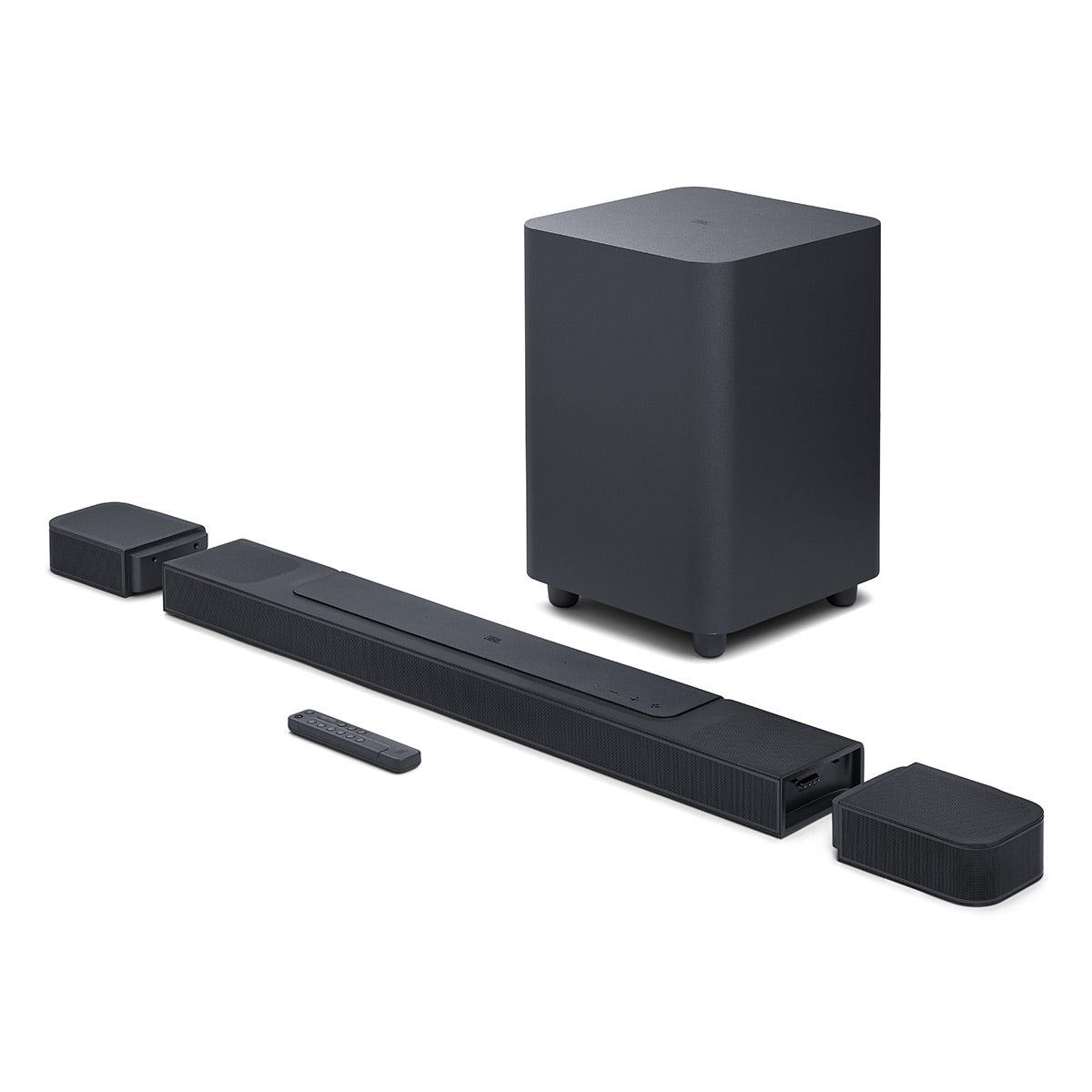
Both systems deliver excellent sound, but in notably different ways:
The AMBEO excels at creating a wide, detailed soundstage - that's the perceived width and depth of the sound. Voices are crystal clear, and the virtual surround effect is impressive for a single unit. However, without an optional external subwoofer, it can't deliver the deepest bass notes that really make you feel action scenes.
The JBL system, with its dedicated subwoofer and physical rear speakers, provides a more conventional but potentially more immersive experience. The 10-inch subwoofer adds real impact to explosions and music, while those detachable rear speakers create genuine surround sound rather than simulated effects.
Both systems are packed with modern connectivity:
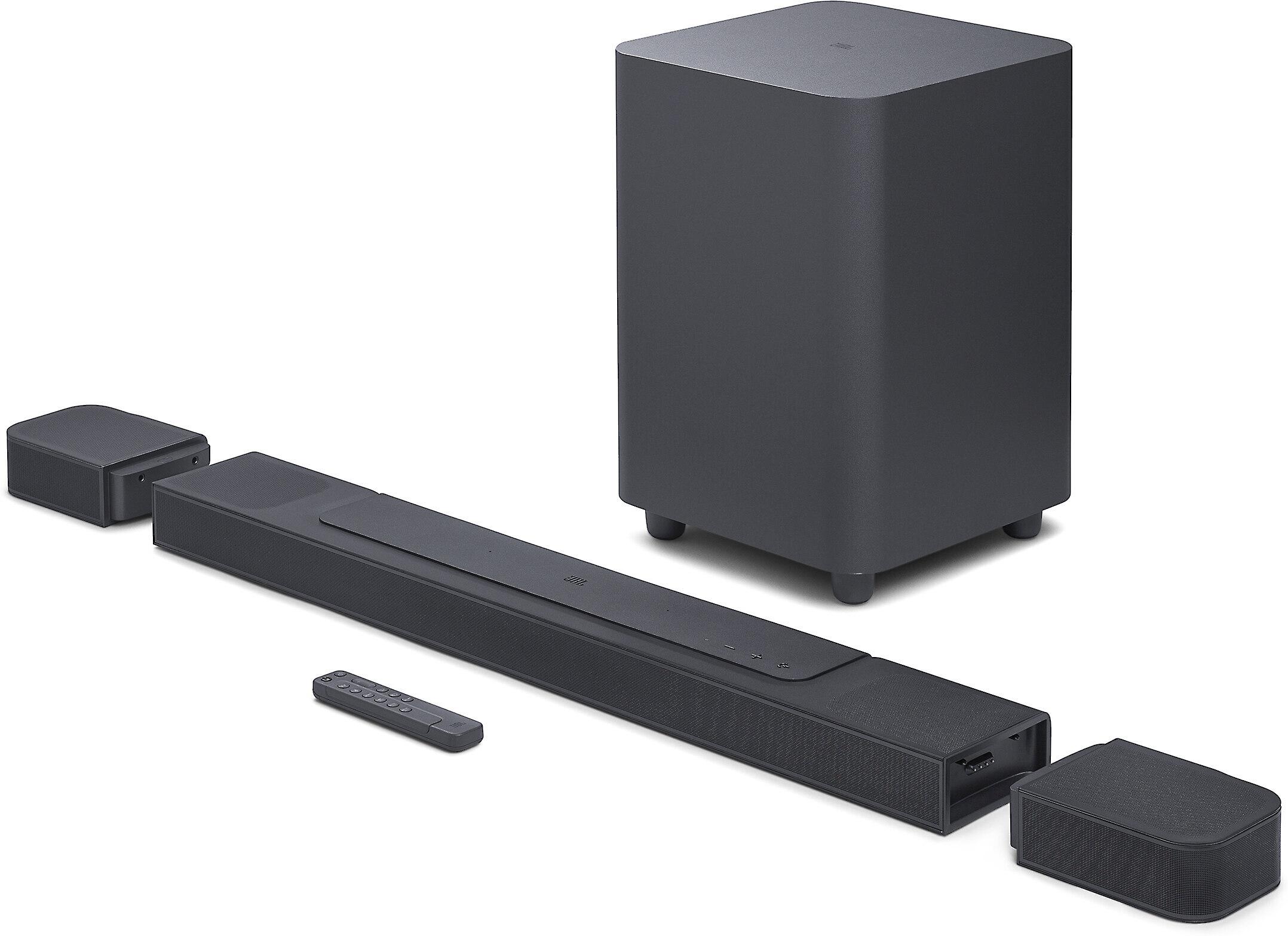
The AMBEO's room calibration deserves special mention - it uses multiple microphones to create a detailed map of your room's acoustics and adjusts accordingly. The JBL's calibration is simpler but still effective.
I've spent time with both systems, and here's what stands out in daily use:
The AMBEO is incredibly elegant. Once mounted, you're done - no extra boxes or wires to manage. The sound quality is consistently impressive, especially for dialogue and music. In my medium-sized living room (about 300 square feet), the virtual surround effect worked surprisingly well, though it becomes less convincing in larger spaces.
The JBL system requires more setup but rewards you with a more cinema-like experience. Those rear speakers really make a difference during movies - when a car drives from front to back of a scene, you genuinely hear it move through the room. The subwoofer adds weight to everything from movie explosions to bass lines in music.
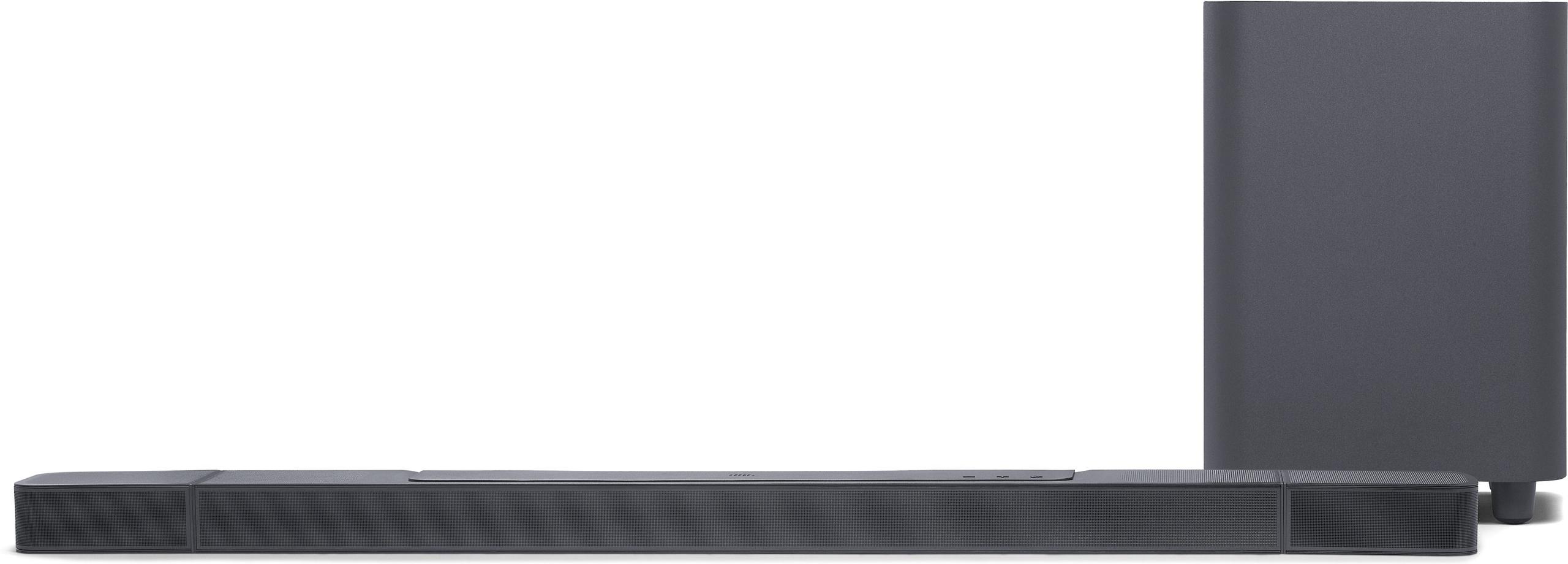
The AMBEO Soundbar Plus at $1,499.95 might seem expensive compared to the JBL Bar 1000 at $1,139.95, especially since the JBL includes a subwoofer and rear speakers. However, the AMBEO's technology and build quality justify its premium position, and its single-unit design might be worth the extra cost for some users.
Both systems have seen software updates since release, improving their performance and adding features. The AMBEO has received several updates enhancing its virtual surround capabilities, while JBL has refined its speaker integration and streaming performance.
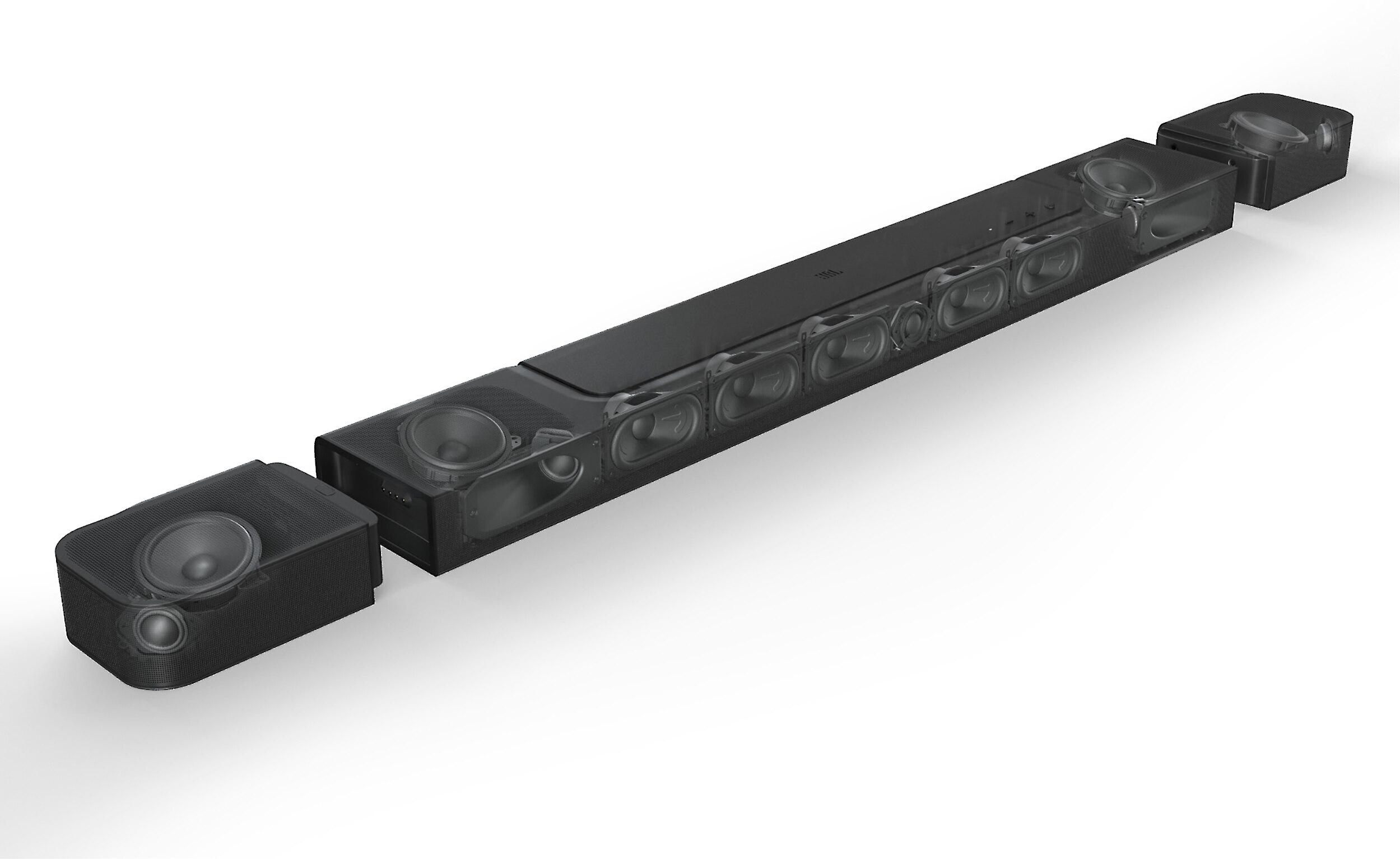
For movie watching, both systems handle dialogue beautifully, but they shine in different scenarios. The AMBEO makes every word crisp and clear, while maintaining an impressive sense of space. The JBL system creates more dramatic effects with its physical speakers, especially during action scenes.
For music, the AMBEO produces a more refined, audiophile-friendly sound, while the JBL system offers more impact and energy, especially in bass-heavy genres.
Consider these key factors:
Both systems represent the current state of the art in home theater audio, just with different philosophies. The AMBEO shows how far we've come in creating immersive sound from a single unit, while the JBL proves there's still value in a more traditional multi-speaker approach.
For my personal setup, I lean toward the AMBEO Soundbar Plus because I value its clean installation and excellent music performance. However, for pure home theater use, especially in larger rooms, the JBL Bar 1000 might be the better choice thanks to its genuine surround sound capabilities and included subwoofer.
The good news is that both systems deliver excellent performance - your choice really comes down to your specific needs, room setup, and how you plan to use it most often.
| Sennheiser AMBEO Soundbar Plus ($1,499.95) | JBL Bar 1000 ($1,139.95) |
|---|---|
| System Design - Impacts installation complexity and sound authenticity | |
| Single-unit soundbar with virtual surround | Multi-component system with physical surrounds |
| Total Power Output - Determines maximum volume and dynamic range | |
| 400W total | 880W total |
| Bass Solution - Critical for movie impact and music depth | |
| Built-in woofers (optional external sub available) | Included 10" wireless subwoofer |
| Surround Sound Approach - Affects how immersive the experience feels | |
| Virtual through beam-forming technology | Physical rear speakers + beam-forming |
| Room Calibration - Better calibration means optimal sound for your space | |
| Advanced self-calibration with multiple built-in mics | Basic one-button room calibration |
| Setup Complexity - Consider your tolerance for installation | |
| Single unit, minimal setup required | Multiple components requiring placement and power |
| Size Requirements - Consider your available space | |
| 27 x 3.5 x 10 inches (single unit) | 47 x 2.8 x 4.7 inches + sub + rear speakers |
| Additional Features - Important for integration with other devices | |
| AirPlay, Chromecast, Alexa, HDMI eARC | AirPlay, Chromecast, Alexa, HDMI eARC |
| Best Use Case - This should heavily influence your decision | |
| Smaller rooms, minimalist setups, music focus | Larger rooms, dedicated home theater, movie focus |
For dedicated home theater use, the JBL Bar 1000 ($1,139.95) edges out the Sennheiser AMBEO Plus ($1,499.95) due to its physical rear speakers and dedicated subwoofer, creating a more authentic cinema experience.
The AMBEO Plus is significantly easier to set up since it's a single unit. The JBL Bar 1000 requires positioning multiple components, including rear speakers and a subwoofer.
The JBL Bar 1000's included 10-inch wireless subwoofer provides deeper, more impactful bass compared to the AMBEO Plus's built-in woofers. However, the AMBEO can be paired with an optional external subwoofer.
The Sennheiser AMBEO Plus costs $1,499.95, while the JBL Bar 1000 is priced at $1,139.95, making the JBL more economical despite including more components.
The AMBEO Plus is ideal for small to medium rooms due to its compact single-unit design and virtual surround technology. The JBL Bar 1000's multiple components might be overkill in smaller spaces.
Yes, both the AMBEO Plus and JBL Bar 1000 support Dolby Atmos, though they deliver it differently - the AMBEO through virtualization and the JBL through physical up-firing speakers.
Both systems offer excellent streaming capabilities with AirPlay, Chromecast, and Bluetooth. The AMBEO Plus tends to have more refined music reproduction, while the JBL offers stronger bass response.
Yes, both the Sennheiser AMBEO Plus and JBL Bar 1000 can be wall-mounted. The AMBEO is simpler to mount since it's a single unit.
Both systems excel at dialogue clarity, but the AMBEO Plus is particularly praised for its voice enhancement technology and clear center channel reproduction.
The JBL Bar 1000 comes complete with everything needed. The AMBEO Plus works alone but can be enhanced with an optional subwoofer for deeper bass response.
Both the AMBEO Plus and JBL Bar 1000 receive regular software updates and support current audio formats. Both are equally future-proof in terms of technology.
For dedicated home theater use, the lower-priced JBL Bar 1000 actually offers better value due to its included subwoofer and rear speakers. The pricier AMBEO Plus makes more sense if you prioritize simplicity and clean installation over maximum immersion.
We've done our best to create useful and informative comparisons to help you decide what product to buy. Our research uses advanced automated methods to create this comparison and perfection is not possible - please contact us for corrections or questions. These are the sites we've researched in the creation of this article: techradar.com - pocket-lint.com - moon-audio.com - stereonet.com - rtings.com - abt.com - projectorscreen.com - youtube.com - videoandaudiocenter.com - crutchfield.com - sennheiser-hearing.com - newsroom.sennheiser.com - zdnet.com - jbl.com - jbl.com - pcrichard.com - rtings.com - d21buns5ku92am.cloudfront.net - ro.harmanaudio.com - target.com - harmanaudio.com - dell.com - mm.jbl.com - dolby.com - jbl.com.my - videoandaudiocenter.com